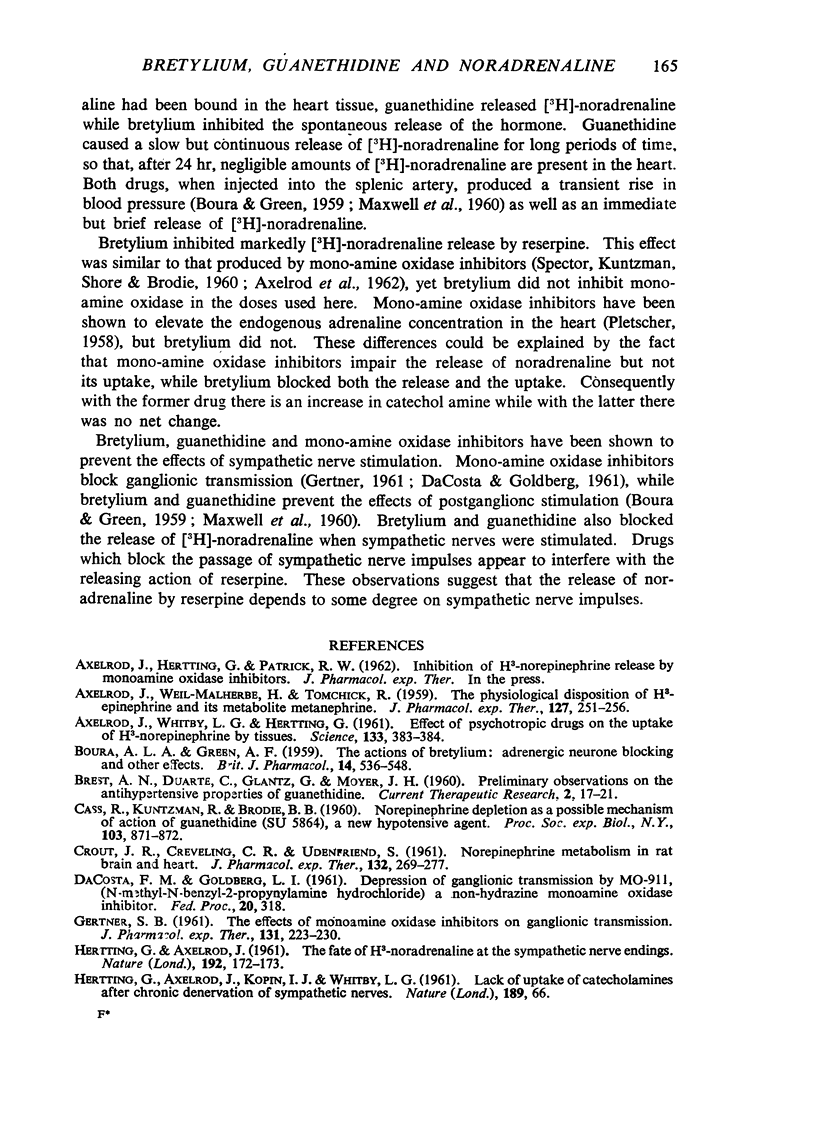Abstract
The effect of bretylium and guanethidine has been studied on the uptake and the spontaneous and reserpine-induced release of [3H]-noradrenaline in the rat heart and in the splenic nerve endings of the cat. Bretylium and guanethidine inhibited the uptake by the heart of circulating [3H]-noradrenaline. Bretylium blocked spontaneous and reserpine-induced release of [3H]-noradrenaline, while guanethidine caused release and partially antagonized the reserpine-induced release. Both compounds produced a transient liberation of [3H]-noradrenaline from splenic nerves, but blocked the release of the [3H]-catechol amine following stimulation of the splenic nerve.
Full text
PDF





Selected References
These references are in PubMed. This may not be the complete list of references from this article.
- AXELROD J., WEIL-MALHERBE H., TOMCHICK R. The physiological disposition of H3-epinephrine and its metabolite metanephrine. J Pharmacol Exp Ther. 1959 Dec;127:251–256. [PubMed] [Google Scholar]
- AXELROD J., WHITBY L. G., HERTTING G. Effect of psychotropic drugs on the uptake of H3-norepinephrine by tissues. Science. 1961 Feb 10;133(3450):383–384. doi: 10.1126/science.133.3450.383. [DOI] [PubMed] [Google Scholar]
- BOURA A. L., GREEN A. F. The actions of bretylium: adrenergic neurone blocking and other effects. Br J Pharmacol Chemother. 1959 Dec;14:536–548. doi: 10.1111/j.1476-5381.1959.tb00961.x. [DOI] [PMC free article] [PubMed] [Google Scholar]
- BREST A. N., DUARTE C., GLANTZ G., MOYER J. H. Preliminary observations on the antihypertensive properties of guanethidine. Curr Ther Res Clin Exp. 1960 Jan;2:17–21. [PubMed] [Google Scholar]
- CASS R., KUNTZMAN R., BRODIE B. B. Norepinephrine depletion as a possible mechanism of action of guanethidine (SU 5864), a new hypotensive agent. Proc Soc Exp Biol Med. 1960 Apr;103:871–872. doi: 10.3181/00379727-103-25702. [DOI] [PubMed] [Google Scholar]
- CROUT J. R., CREVELING C. R., UDENFRIEND S. Norepinephrine metabolism in rat brain and heart. J Pharmacol Exp Ther. 1961 Jun;132:269–277. [PubMed] [Google Scholar]
- GERTNER S. B. The effects of monoamine oxidase inhibitors on ganglionic transmission. J Pharmacol Exp Ther. 1961 Feb;131:223–230. [PubMed] [Google Scholar]
- HERTING G., AXELROD J., WHITBY L. G. Effect of drugs on the uptake and metabolism of H3-norepinephrine. J Pharmacol Exp Ther. 1961 Nov;134:146–153. [PubMed] [Google Scholar]
- HERTTING G., AXELROD J. Fate of tritiated noradrenaline at the sympathetic nerve-endings. Nature. 1961 Oct 14;192:172–173. doi: 10.1038/192172a0. [DOI] [PubMed] [Google Scholar]
- HERTTING G., AXELROD J., KOPIN I. J., WHITBY L. G. Lack of uptake of catecholamines after chronic denervation of sympathetic nerves. Nature. 1961 Jan 7;189:66–66. doi: 10.1038/189066a0. [DOI] [PubMed] [Google Scholar]
- MAXWELL R. A., MULL R. P., PLUMMER A. J. [2-Octahydro-1-azocinyl)-ethyl]-guanidine sulfate (CIBA 5864-SU), a new synthetic antithypertensive agents]. Experientia. 1959 Jul 15;15:267–267. doi: 10.1007/BF02158076. [DOI] [PubMed] [Google Scholar]
- PAGE I. H., DUSTAN H. P. A new, potent antihypertensive drug: preliminary study of [2-(octahydro-1-azocinyl)-ethyl]-guanidine sulfate (guanethidine). J Am Med Assoc. 1959 Jul 11;170(11):1265–1271. doi: 10.1001/jama.1959.03010110013003. [DOI] [PubMed] [Google Scholar]
- PLETSCHER A. Einfluss von Isopropylisonikotinsäurehydrazid auf den Katecholamingehalt des Myokards. Experientia. 1958 Feb 15;14(2):73–74. doi: 10.1007/BF02159014. [DOI] [PubMed] [Google Scholar]
- WHITBY L. G., AXELROD J., WEIL-MALHERBE H. The fate of H3-norepinephrine in animals. J Pharmacol Exp Ther. 1961 May;132:193–201. [PubMed] [Google Scholar]


